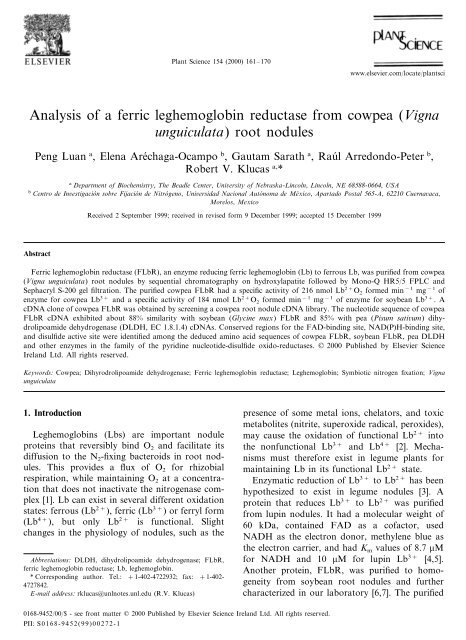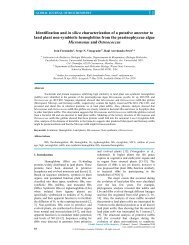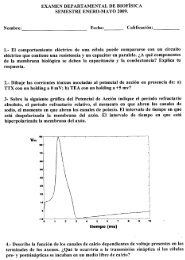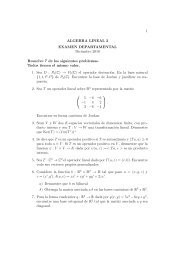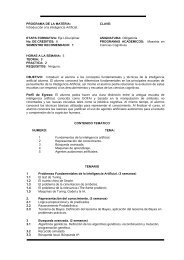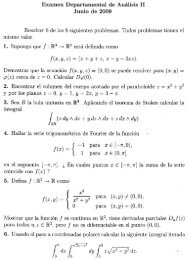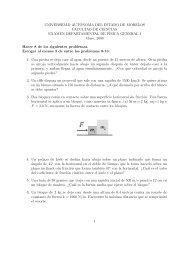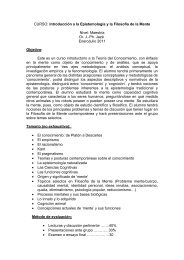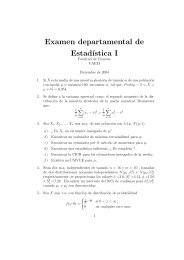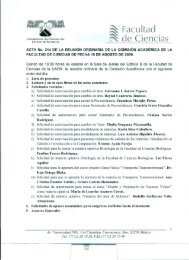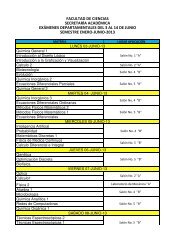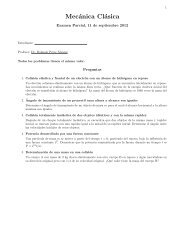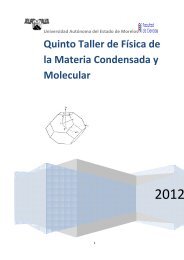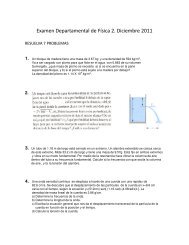Analysis of a ferric leghemoglobin reductase from cowpea (Vigna ...
Analysis of a ferric leghemoglobin reductase from cowpea (Vigna ...
Analysis of a ferric leghemoglobin reductase from cowpea (Vigna ...
Create successful ePaper yourself
Turn your PDF publications into a flip-book with our unique Google optimized e-Paper software.
Plant Science 154 (2000) 161–170<br />
<strong>Analysis</strong> <strong>of</strong> a <strong>ferric</strong> <strong>leghemoglobin</strong> <strong>reductase</strong> <strong>from</strong> <strong>cowpea</strong> (<strong>Vigna</strong><br />
unguiculata) root nodules<br />
Peng Luan a , Elena Aréchaga-Ocampo b , Gautam Sarath a , Raúl Arredondo-Peter b ,<br />
Robert V. Klucas a, *<br />
a Department <strong>of</strong> Biochemistry, The Beadle Center, Uniersity <strong>of</strong> Nebraska-Lincoln, Lincoln, NE 68588-0664, USA<br />
b Centro de Inestigación sobre Fijación de Nitrógeno, Uniersidad Nacional Autónoma de México, Apartado Postal 565-A, 62210 Cuernaaca,<br />
Morelos, Mexico<br />
Abstract<br />
Received 2 September 1999; received in revised form 9 December 1999; accepted 15 December 1999<br />
www.elsevier.com/locate/plantsci<br />
Ferric <strong>leghemoglobin</strong> <strong>reductase</strong> (FLbR), an enzyme reducing <strong>ferric</strong> <strong>leghemoglobin</strong> (Lb) to ferrous Lb, was purified <strong>from</strong> <strong>cowpea</strong><br />
(<strong>Vigna</strong> unguiculata) root nodules by sequential chromatography on hydroxylapatite followed by Mono-Q HR5/5 FPLC and<br />
Sephacryl S-200 gel filtration. The purified <strong>cowpea</strong> FLbR had a specific activity <strong>of</strong> 216 nmol Lb 2+ O 2 formed min −1 mg −1 <strong>of</strong><br />
enzyme for <strong>cowpea</strong> Lb 3+ and a specific activity <strong>of</strong> 184 nmol Lb 2+ O 2 formed min −1 mg −1 <strong>of</strong> enzyme for soybean Lb 3+ .A<br />
cDNA clone <strong>of</strong> <strong>cowpea</strong> FLbR was obtained by screening a <strong>cowpea</strong> root nodule cDNA library. The nucleotide sequence <strong>of</strong> <strong>cowpea</strong><br />
FLbR cDNA exhibited about 88% similarity with soybean (Glycine max) FLbR and 85% with pea (Pisum satium) dihydrolipoamide<br />
dehydrogenase (DLDH, EC 1.8.1.4) cDNAs. Conserved regions for the FAD-binding site, NAD(P)H-binding site,<br />
and disulfide active site were identified among the deduced amino acid sequences <strong>of</strong> <strong>cowpea</strong> FLbR, soybean FLbR, pea DLDH<br />
and other enzymes in the family <strong>of</strong> the pyridine nucleotide-disulfide oxido-<strong>reductase</strong>s. © 2000 Published by Elsevier Science<br />
Ireland Ltd. All rights reserved.<br />
Keywords: Cowpea; Dihyrodrolipoamide dehydrogenase; Ferric <strong>leghemoglobin</strong> <strong>reductase</strong>; Leghemoglobin; Symbiotic nitrogen fixation; <strong>Vigna</strong><br />
unguiculata<br />
1. Introduction<br />
Leghemoglobins (Lbs) are important nodule<br />
proteins that reversibly bind O 2 and facilitate its<br />
diffusion to the N 2-fixing bacteroids in root nodules.<br />
This provides a flux <strong>of</strong> O 2 for rhizobial<br />
respiration, while maintaining O 2 at a concentration<br />
that does not inactivate the nitrogenase complex<br />
[1]. Lb can exist in several different oxidation<br />
states: ferrous (Lb 2+ ), <strong>ferric</strong> (Lb 3+ ) or ferryl form<br />
(Lb 4+ ), but only Lb 2+ is functional. Slight<br />
changes in the physiology <strong>of</strong> nodules, such as the<br />
Abbreiations: DLDH, dihydrolipoamide dehydrogenase; FLbR,<br />
<strong>ferric</strong> <strong>leghemoglobin</strong> <strong>reductase</strong>; Lb, <strong>leghemoglobin</strong>.<br />
* Corresponding author. Tel.: +1-402-4722932; fax: +1-402-<br />
4727842.<br />
E-mail address: rklucas@unlnotes.unl.edu (R.V. Klucas)<br />
0168-9452/00/$ - see front matter © 2000 Published by Elsevier Science Ireland Ltd. All rights reserved.<br />
PII: S0168-9452(99)00272-1<br />
presence <strong>of</strong> some metal ions, chelators, and toxic<br />
metabolites (nitrite, superoxide radical, peroxides),<br />
may cause the oxidation <strong>of</strong> functional Lb 2+ into<br />
the nonfunctional Lb 3+ and Lb 4+ [2]. Mechanisms<br />
must therefore exist in legume plants for<br />
maintaining Lb in its functional Lb 2+ state.<br />
Enzymatic reduction <strong>of</strong> Lb 3+ to Lb 2+ has been<br />
hypothesized to exist in legume nodules [3]. A<br />
protein that reduces Lb 3+ to Lb 2+ was purified<br />
<strong>from</strong> lupin nodules. It had a molecular weight <strong>of</strong><br />
60 kDa, contained FAD as a c<strong>of</strong>actor, used<br />
NADH as the electron donor, methylene blue as<br />
the electron carrier, and had K m values <strong>of</strong> 8.7 M<br />
for NADH and 10 M for lupin Lb 3+ [4,5].<br />
Another protein, FLbR, was purified to homogeneity<br />
<strong>from</strong> soybean root nodules and further<br />
characterized in our laboratory [6,7]. The purified
162<br />
soybean FLbR was a homodimer with a molecular<br />
weight <strong>of</strong> 110 kDa, contained FAD as a<br />
prosthetic group, and used NAD(P)H as the<br />
electron donor to reduce Lb 3+ . It also exhibited<br />
diaphorase activity [6]. The enzyme required O 2<br />
at the micromolar levels for the reduction <strong>of</strong><br />
Lb 3+ to Lb 2+ in vitro, had K m values <strong>of</strong> 7 M<br />
for NADH, 9.5 M for soybean Lb 3+ , and a<br />
V max value for soybean Lb 3+ reduction <strong>of</strong> 499<br />
nmol Lb 2+ O 2 formed min −1 mg −1 [7]. A cDNA<br />
encoding soybean FLbR was cloned and sequenced<br />
[8] and subsequently overexpressed in<br />
Escherichia coli [9]. Based on sequence homology,<br />
soybean FLbR was shown to be related to<br />
a family <strong>of</strong> pyridine nucleotide-disulfide oxido-<strong>reductase</strong>s,<br />
especially the DLDHs <strong>from</strong> various<br />
sources [9].<br />
The only FLbR that had been characterized to<br />
date is <strong>from</strong> soybean root nodules. To investigate<br />
if this enzyme is present in other legumes<br />
nodules, we used <strong>cowpea</strong> (<strong>Vigna</strong> unguiculata)<br />
root nodules for our study. In this work we describe<br />
(1) the identification and purification <strong>of</strong><br />
FLbR <strong>from</strong> <strong>cowpea</strong> root nodules; (2) some <strong>of</strong><br />
the important physical and enzymatic properties<br />
<strong>of</strong> <strong>cowpea</strong> FLbR; (3) the sequences <strong>of</strong> the<br />
cDNA encoding <strong>cowpea</strong> FLbR; and (4) the comparison<br />
<strong>of</strong> deduced <strong>cowpea</strong> FLbR amino acids<br />
sequence with soybean FLbR and other similar<br />
proteins. The results revealed that the <strong>cowpea</strong><br />
FLbR is very similar to the soybean enzyme,<br />
and indeed FLbR may be common to all<br />
legumes root nodules.<br />
2. Materials and methods<br />
2.1. Chemicals<br />
Chemicals were reagent or molecular biology<br />
grade. Bio-Gel-hydroxylapatite, Bio-Gel P6-DG,<br />
silver staining kit, and protein concentration assay<br />
kit were purchased <strong>from</strong> Bio Rad. Prepacked<br />
Mono-Q HR5/5 column, Sephacryl S-200<br />
Super Fine (SF), Sephadex G-25 and G-75 were<br />
<strong>from</strong> Pharmacia. Agarose, bacteria broth, Taq<br />
DNA polymerase, PCR reagents and DNA ligation<br />
reagents were <strong>from</strong> Gibco-BRL. Hybridization<br />
materials were <strong>from</strong> Boehringer Mannheim.<br />
Other chemicals were <strong>from</strong> Sigma and Fisher unless<br />
noted.<br />
P. Luan et al. / Plant Science 154 (2000) 161–170<br />
2.2. Purification <strong>of</strong> <strong>cowpea</strong> FLbR <strong>from</strong> root<br />
nodules<br />
Germinated <strong>cowpea</strong> seeds (V. unguiculata, cv.<br />
Blackeye peas, 137-California No. 5) were<br />
inoculated with Bradyrhizobium japonicum USDA<br />
3456 before planting. The bacteria and plants were<br />
grown as described by Becana et al. [10]. Cowpea<br />
root nodules were harvested <strong>from</strong> 5 weeks old<br />
plants, and stored at −90°C. All purification<br />
steps were carried out at 4°C, essentially following<br />
the procedure <strong>of</strong> Ji et al. [7]. Active fractions were<br />
collected, pooled, made to a final concentration <strong>of</strong><br />
10% with glycerol and stored at −90°C.<br />
Homogeneity <strong>of</strong> the sample after each purification<br />
step was analyzed by 10% SDS-PAGE stained<br />
using the Bio-Rad Silver-Stain Kit. Protein<br />
concentration was determined using Bio Rad<br />
protein micro-assay procedure and bovine serum<br />
albumin as a standard.<br />
2.3. Isolation <strong>of</strong> <strong>cowpea</strong> Lb and soybean Lb<br />
Isolation and oxidization <strong>of</strong> <strong>cowpea</strong> and soybean<br />
Lb were as described earlier [10,11]. Lb<br />
was stored as Lb 3+ at −90°C until use.<br />
2.4. FLbR actiity and diaphorase actiity assay<br />
FLbR activity was assayed according to the<br />
procedure used by Ji et al. [7] on a Milton Roy<br />
Spectronic 3000 Array spectrophotometer<br />
equipped with kinetic acquisition s<strong>of</strong>tware. The<br />
absorbance change was converted to Lb 2+ O 2<br />
formation rate using the n <strong>of</strong> 10.2 mM −1 cm −1<br />
(Lb 2+ O 2 minus Lb 3+ ) at 574 nm. FLbR specific<br />
activity was expressed as nmol Lb 2+ O 2 formed<br />
min −1 mg −1 <strong>of</strong> protein. Diaphorase activity was<br />
assayed using DCPIP as described by Ji et al. [7].<br />
Diaphorase specific activity was expressed as nmol<br />
DCPIP reduced min −1 mg −1 <strong>of</strong> protein.<br />
2.5. N-Terminal sequencing<br />
Approximately 20 pmol (2 g) <strong>of</strong> purified<br />
<strong>cowpea</strong> FLbR was separated by 10% SDS-PAGE<br />
and then transferred to a polyvinylidene difluoride<br />
membrane (Millipore). The membrane was stained<br />
with Amido Black solution to visualize proteins.<br />
The band corresponding to the FLbR was excised<br />
<strong>from</strong> the membrane and sequenced on an ABI
Instruments Procise 494 Protein Sequencer at the<br />
Protein Core Facility at University <strong>of</strong> Nebraska-<br />
Lincoln.<br />
2.6. Characterization <strong>of</strong> <strong>cowpea</strong> FLbR<br />
Molecular weight <strong>of</strong> native FLbR was determined<br />
using a gel filtration method [12] on a<br />
Sephacryl S-200 SF column. The <strong>cowpea</strong> FLbR<br />
activity was assayed in different pH buffers to<br />
determine its optimal pH, using <strong>cowpea</strong> Lb 3+ as the<br />
substrate. The buffers used were: 50 mM potassium<br />
phosphate at pH 3.7, 4.8; 50 mM MES at pH 5.5,<br />
6.0, 6.5, 7.0; and 50 mM Tris–HCl at pH 7.5, 8.5.<br />
Reduction <strong>of</strong> <strong>cowpea</strong> and soybean Lb 3+ by<br />
<strong>cowpea</strong> FLbR was followed spectrophotometrically<br />
using an assay mixture that contained 50 mM<br />
potassium phosphate, pH 6.5, 2 g <strong>cowpea</strong> FLbR,<br />
500 M NADH, and various concentrations <strong>of</strong><br />
<strong>cowpea</strong> or soybean Lb 3+ (0–50 M) in a final<br />
volume <strong>of</strong> 1 ml. K m and V max values for <strong>cowpea</strong> or<br />
soybean Lb 3+ were determined by fitting the data<br />
to the Michaelis–Menten equation or Lineweaver–<br />
Burk plot using commercial s<strong>of</strong>tware (Grafit version<br />
2.0). The K m value for NADH was determined<br />
as above using reaction mixture that contained 50<br />
mM potassium phosphate, pH 6.5, 50 M <strong>cowpea</strong><br />
Lb, 2 g <strong>cowpea</strong> FLbR, and various concentrations<br />
<strong>of</strong> NADH (0–500 M).<br />
2.7. Construction <strong>of</strong> a <strong>cowpea</strong> root nodule cDNA<br />
library<br />
Poly(A + ) mRNAs were isolated <strong>from</strong> 0.5 g <strong>of</strong><br />
frozen <strong>cowpea</strong> root nodules, and used as a template<br />
to generate cDNAs. The cDNAs were ligated with<br />
a EcoRI/NotI adapter and subsequently ligated to<br />
the gt11 arms following the supplier’s procedures<br />
(Pharmacia). The cDNA-gt11 constructs were<br />
packaged into commercial available phage particles<br />
and then amplified using E. coli strain Y1090<br />
following the suppliers procedures (Pharmacia<br />
Ready-To-Go Lambda Packaging Kit). The cDNA<br />
library was divided into 2-ml aliquots and stored at<br />
−90°C.<br />
2.8. Obtaining the cDNA sequence <strong>of</strong> <strong>cowpea</strong><br />
FLbR<br />
Two primers, named FLbR Fwd (5-<br />
AAATCTCTGTAGACACCA-3) and FLbR Rvs<br />
P. Luan et al. / Plant Science 154 (2000) 161–170 163<br />
(5-GCCTTAGCTCTGCTATTA-3), were designed<br />
based on the soybean FLbR cDNA sequence<br />
(positions 485–502 and 1272–1289, respectively,<br />
<strong>from</strong> Ji et al. [8]). They were used for the amplification<br />
<strong>of</strong> an internal FLbR fragment by PCR at high<br />
stringency (annealing temperature <strong>of</strong> 55°C for 1<br />
min) using aliquots <strong>of</strong> a <strong>cowpea</strong> root nodule cDNA<br />
library (above) as template. PCR products were<br />
resolved in a 1.2% agarose gel, the band <strong>of</strong> the<br />
expected size (800 bp) was cut out and extracted<br />
in 10 l <strong>of</strong> sterile water using a Gene Clean II Kit<br />
(Bio 101) following the supplier’s manual. The<br />
extracted DNA was cloned in the pCR2.1 vector<br />
(Invitrogen) and sequenced (see below), and then<br />
used as a probe for screening the cDNA library<br />
<strong>from</strong> <strong>cowpea</strong> nodules as described by Sambrook et<br />
al. [13]. Positive plaques were picked and eluted into<br />
50 l <strong>of</strong> SM solution [13].<br />
Two primers, named Forward and Reverse,<br />
were used for the amplification <strong>of</strong> inserts <strong>from</strong> the<br />
positive plaques essentially as described by Arredondo-Peter<br />
et al. [14]. Amplified inserts were<br />
resolved in a 0.8% agarose gel, extracted using the<br />
Gene Clean II Kit, cloned in the vector pCR2.1, and<br />
subsequently transformed in E. coli InvF cells<br />
(Invitrogen) for DNA sequencing. The FLbR<br />
cDNA inserts were fully-sequenced in both directions<br />
at the DNA Sequencing Facility <strong>of</strong> the University<br />
<strong>of</strong> Nebraska-Lincoln. Cowpea FLbR<br />
nucleotide sequence and the deduced polypeptide<br />
sequence were searched for similarity in databases<br />
(GeneBank, EMBL, SwissProt) using programs <strong>of</strong><br />
the GCG package (Wisconsin Computer Group,<br />
version 8.0).<br />
3. Results and discussion<br />
3.1. Purification <strong>of</strong> <strong>cowpea</strong> FLbR<br />
FLbR was purified to homogeneity <strong>from</strong> crude<br />
extracts <strong>of</strong> <strong>cowpea</strong> root nodules by a four-step<br />
procedure involving ammonium sulfate precipitation,<br />
hydroxylapatite, ion exchange and size-exclusion<br />
chromatography. The purified <strong>cowpea</strong> FLbR<br />
had a specific activity <strong>of</strong> 216 nmol Lb 2+ O 2 min −1<br />
mg −1 <strong>of</strong> protein, which corresponded to a purification<br />
<strong>of</strong> approximately 1000-fold and a yield <strong>of</strong> 16%<br />
(Table 1). The hydroxylapatite column was an<br />
important step in the purification which resulted a<br />
60-fold increase in specific activity <strong>of</strong> FLbR al-
164<br />
though approximately 50% <strong>of</strong> the total activity<br />
was lost. A 40-fold decrease in the ratio <strong>of</strong> diaphorase<br />
to FLbR activity (Table 1) indicated that<br />
many <strong>of</strong> the other contaminating diaphorases were<br />
removed at this step. On the FPLC anion exchange<br />
column, FLbR was eluted as a sharp peak<br />
at about 15% <strong>of</strong> NaCl gradient (150 mM NaCl,<br />
Fig. 1). The specific activity <strong>of</strong> the purified <strong>cowpea</strong><br />
FLbR was about 50% <strong>of</strong> that reported for the<br />
soybean enzyme [7]. The difference in the specific<br />
activities between the <strong>cowpea</strong> and soybean FLbRs<br />
could result <strong>from</strong> inherent differences in the two<br />
enzymes.<br />
P. Luan et al. / Plant Science 154 (2000) 161–170<br />
Table 1<br />
Purification and specific activities <strong>of</strong> FLbR <strong>from</strong> <strong>cowpea</strong> nodule cytosol a<br />
3.2. Homogeneity and molecular weight analysis<br />
<strong>of</strong> <strong>cowpea</strong> FLbR<br />
Samples collected <strong>from</strong> each purification step<br />
were subjected to 10% SDS-PAGE and silver<br />
staining (Fig. 2). The sample after the Sephacryl<br />
S-200 step (lane 4) exhibited a single distinct<br />
protein band <strong>of</strong> about 55 kDa. The molecular<br />
weight for native <strong>cowpea</strong> FLbR was estimated to<br />
be 110 kDa using the Sephacryl S-200 SF column<br />
(data not shown) and thus appears to be a homodimer.<br />
These molecular weights were similar to<br />
those reported for soybean FLbR [7].<br />
Steps Total protein DCIP <strong>reductase</strong> (A) specific activity<br />
Ratio A/Bd FLbR (B) specific activity Total FLbR<br />
(mg) (U mg−1 ) c<br />
(U mg−1 ) b activity (U)<br />
Crude extract 893 187 0.22 194<br />
850<br />
G-25 607 254 0.29 176 875<br />
Hydroxylapatite<br />
4.5 368<br />
17.3<br />
78<br />
21.3<br />
Mono-Q 0.31 2289 162 50 14.1<br />
S-200 0.15 2565<br />
216 32 11.9<br />
a Purification steps are described in Section 2.<br />
b One unit is defined as 1 nmol <strong>of</strong> DCPIP reduced per min.<br />
c One unit is defined as 1 nmol <strong>of</strong> Lb 2+ O2 formed per min.<br />
d This is the ratio <strong>of</strong> DCPIP <strong>reductase</strong> (diaphorase) specific activity to FLbR specific activity.<br />
Fig. 1. Separation <strong>of</strong> FLbR by an ion-exchange FPLC on a Mono-Q HR5/5 column. The column was equilibrated with Buffer<br />
A (50 mM Tris–HCl, pH 7.5), and eluted with a linear NaCl gradient <strong>from</strong> 0 to 35% <strong>of</strong> Buffer B (1 M NaCl, 50 mM Tris–HCl,<br />
pH 7.5) in 50 ml total volume (Buffer A plus Buffer B) at a flow rate <strong>of</strong> 1 ml min −1 . Cowpea FLbR was eluted at about 15%<br />
<strong>of</strong> the gradient (150 mM NaCl, as indicated by the arrow).
Fig. 2. SDS-Polyacrylamide gel electrophoresis <strong>of</strong> <strong>cowpea</strong><br />
FLbR fractions during purification. The gel was silver-stained<br />
to detect proteins. Lane 1, G-25 fraction (50 g protein); lane<br />
2, hydroxylapatite fraction (10 g protein); lane 3, Mono-Q<br />
fraction (5 g protein); lane 4, Sephacryl S-200 fraction (3 g<br />
protein); and lane 5, 10-kDa ladder (10 g protein).<br />
P. Luan et al. / Plant Science 154 (2000) 161–170 165<br />
3.3. Characterization <strong>of</strong> <strong>cowpea</strong> FLbR<br />
The first 20 amino acids on the N-terminus <strong>of</strong><br />
the <strong>cowpea</strong> FLbR were determined to be: A-S-G-<br />
S-D-E-N-D-V-V-V-I-G-G-G-P-G-G-Y-V. When<br />
this sequence was compared to sequences deposited<br />
in the GCG database, it was found to be<br />
100% identical with soybean FLbR, and 95.2%<br />
identical with pea DLDH. This indicates that the<br />
FLbRs and DLDHs are probably highly conserved<br />
in legumes.<br />
The purified <strong>cowpea</strong> FLbR reduced both<br />
<strong>cowpea</strong> Lb 3+ and soybean Lb 3+ at comparable<br />
rates in the presence <strong>of</strong> NADH, forming Lb 2+ O 2<br />
under aerobic conditions. The enzyme had maximum<br />
Lb 3+ reduction activity at pH 6.5, and had<br />
no activity at pH values below pH 4.8 or above<br />
pH 8.5. Reactions as a function <strong>of</strong> time were<br />
monitored spectrometrically for the reduction <strong>of</strong><br />
Fig. 3. Reduction <strong>of</strong> <strong>cowpea</strong> Lb 3+ by FLbR. Reaction mixture contained 50 mM potassium phosphate buffer, pH 6.5, 500 M<br />
NADH, 50 M <strong>cowpea</strong> Lb 3+ , and 2 g purified <strong>cowpea</strong> FLbR. The reaction was carried out in a 1-ml cuvette at room<br />
temperature, and the spectra were scanned at 5-min intervals.
166<br />
Table 2<br />
Kinetic properties <strong>of</strong> <strong>cowpea</strong> FLbR, soybean FLbR and pig<br />
DLDH<br />
P. Luan et al. / Plant Science 154 (2000) 161–170<br />
Vmax Kcat (s−1 )<br />
(U mg−1 ) (M−1s−1 )<br />
K m (M) K cat/K m<br />
Cowpea FLbR<br />
10.4 221a Cowpea<br />
Lb<br />
3.1 298<br />
3+<br />
Soybean 12.4 185a 2.5 201<br />
Lb 3+<br />
NADH 57 NA NA NA<br />
Soybean FLbR a,b<br />
Soybean 9.2 450 6.2 674<br />
Lb 3+<br />
NADH 46 16 000 220 4.8<br />
Lipoamide 716<br />
NA NA NA<br />
Pig DLDH b,c<br />
Soybean 28 350 1.1 40<br />
Lb 3+<br />
NADH 73 25 000 344 4.5<br />
Lipoamide 430<br />
NA NA NA<br />
a One enzyme unit is defined as 1 nmol <strong>of</strong> Lb 2+ O2 formed<br />
min−1 mg−1 .<br />
b Determined by Ji et al. [9].<br />
c One enzyme unit is defined as 1 nmol NADH oxidized<br />
min−1 mg−1 .<br />
<strong>cowpea</strong> Lb 3+ (Fig. 3) and soybean Lb 3+ . The<br />
absorption at 541 and 574 nm, which was contributed<br />
by Lb 2+ O 2, increased as a function <strong>of</strong><br />
time, whereas the absorption at 627 nm resulting<br />
<strong>from</strong> Lb 3+ decreased. Two isosbestic points at 525<br />
and 588 nm were present in the reduction <strong>of</strong><br />
<strong>cowpea</strong> Lb 3+ . The spectroscopic characteristics<br />
for the reduction <strong>of</strong> <strong>cowpea</strong> Lb 3+ by <strong>cowpea</strong><br />
FLbR were similar to those reported for the soybean<br />
enzyme [7,9].<br />
The K m and V max values <strong>of</strong> <strong>cowpea</strong> FLbR for<br />
<strong>cowpea</strong> Lb 3+ reduction were determined to be<br />
10.4 M and 221 U mg −1 , respectively. The corresponding<br />
K m and V max values for soybean Lb 3+<br />
reduction by <strong>cowpea</strong> FLbR were determined to be<br />
12.4 M and 185 U mg −1 , respectively. The K m<br />
value for NADH by the <strong>cowpea</strong> FLbR was determined<br />
to be 57 M (Table 2). These values are<br />
similar to those reported for soybean FLbR [7,9].<br />
The K cat (6.2 s −1 ) and K cat/K m values (674 M −1<br />
s −1 ) <strong>of</strong> soybean enzyme were about tw<strong>of</strong>old<br />
greater than the <strong>cowpea</strong> enzyme, 3.1 s −1 and 298<br />
M −1 s −1 , respectively (Table 2). The K m value <strong>of</strong><br />
pig DLDH for soybean Lb 3+ (28 M) was more<br />
than tw<strong>of</strong>old higher than those <strong>of</strong> <strong>cowpea</strong> FLbR<br />
(12.4 M) and soybean FLbR (9.2 M) for Lb 3+<br />
(Table 2). The catalytic efficiencies (K cat/K m) <strong>of</strong><br />
<strong>cowpea</strong> FLbR for <strong>cowpea</strong> Lb 3+ (298 M −1 s −1 )<br />
and soybean FLbR for soybean Lb 3+ (674 M −1<br />
s −1 ) were about eight- and 17-fold higher than<br />
that <strong>of</strong> pig DLDH (40 M −1 s −1 ) (Table 2). Conversely,<br />
the affinity <strong>of</strong> pig DLDH for lipoamide<br />
was higher than the two FLbRs. These data suggest<br />
that dehydrogenation <strong>of</strong> lipoamide is most<br />
efficiently catalyzed by DLDH, and reduction <strong>of</strong><br />
Lb 3+ is most efficiently catalyzed by FLbRs.<br />
Thus, although DLDH and FLbRs exhibit many<br />
similarities in their enzyme kinetics, they are expected<br />
to function differently in vivo.<br />
3.4. cDNA sequence <strong>of</strong> <strong>cowpea</strong> FLbR<br />
A cDNA fragment <strong>of</strong> 802 bp was amplified<br />
<strong>from</strong> a <strong>cowpea</strong> root nodule cDNA library by PCR<br />
using the FLbR Fwd and FLbR Rvs primers.<br />
DNA sequencing showed that the 802-bp PCRfragment<br />
encoded for a <strong>cowpea</strong> FLbR. Thus, this<br />
fragment was PCR-labelled by incorporating Dig-<br />
11-dUTP [15] and used as probe for screening the<br />
above <strong>cowpea</strong> cDNA library. About 5×10 5 recombinant<br />
phage plaques were screened, resulting<br />
in seven positive plaques that were numbered c1<br />
through c7. The inserts <strong>from</strong> these plaques were<br />
amplified by PCR using primers [14]. Inserts<br />
<strong>from</strong> plaques c4 and c6 (named clones 4 and 6)<br />
were about 1.8 kb in length and thus they were<br />
subcloned for DNA sequencing. Sequence comparison<br />
showed that clones 4 and 6 are copies <strong>of</strong><br />
the same cDNA, and that they code for the same<br />
protein. Comparison with sequences deposited in<br />
the GenBank database revealed that clones 4 and<br />
6 have high similarity (80%, see below) to the<br />
soybean FLbR, and other DHLD sequences, and<br />
thus that they code for a <strong>cowpea</strong> FLbR.<br />
The complete <strong>cowpea</strong> FLbR cDNA consists <strong>of</strong><br />
1797 nucleotides with an open reading frame <strong>of</strong><br />
1569 bases (Fig. 4). The poly(A + )11 tail is present<br />
150 bases after the stop codon position. The deduced<br />
polypeptide sequence has 523 amino acids<br />
with a predicted molecular weight <strong>of</strong> 56 kDa,<br />
which corresponds well to the observed value <strong>of</strong> 55
P. Luan et al. / Plant Science 154 (2000) 161–170 167<br />
Fig. 4. Nucleotide and deduced amino acid sequences <strong>of</strong> <strong>cowpea</strong> FLbR. The experimentally determined N-terminal amino acid<br />
sequence <strong>of</strong> the purified enzyme is underlined in the amino acid sequence. The deduced leader sequence is indicated in italics<br />
(amino acid residues 1–30). The cysteine residues hypothesized to form the active disulfide bond are asterisked.
Table 3<br />
Conserved domains in <strong>cowpea</strong> FLbR a<br />
Conserved sequences in the FAD-binding domain<br />
FLbR-<strong>cowpea</strong> 37–66 N D V V V I G G G P G G Y V A A I K A S Q L G L K T T C I E<br />
FLbR-soybean · · · · · · · · · · · · · · · · A<br />
b 37–66 · · ·<br />
· · · · · · · · · ·<br />
DLDH-pea I · · · · ·<br />
b 38–67 · · · ·<br />
· · · · · · · · · A · · · F · · · · · ·<br />
DLDH-human 42–71 T · · · S · · · · · · · · · · · A · · · F · · V · · ·<br />
b A · ·<br />
DLDH-yeast 28–56 – · · · I · · · · · A · · · · · · · · A · · · F N · A · V ·<br />
b<br />
DLDH-E. coli · L · · · · A<br />
b 6–35 T Q · ·<br />
· · S · · F R C A D · · · E · V I V ·<br />
GSHR-human L · · · · · S · · L A S · R R · A<br />
b 21–50 Y · Y<br />
E · · A R A A V V ·<br />
GSHR-E. coli b 5–34 T · T I A · · · · S · · I A S I N R · A M Y · Q · C A L · ·<br />
Conserved sequences in the disulfide active site<br />
L G G T CcL N V G Cc FLbR-<strong>cowpea</strong> 67–96 K R G T<br />
I P S K A L L H S S H M Y H E A<br />
FLbR-soybean 67–96 · · · · · · · · · · · · · · · · · · · · · · · · · · · · · ·<br />
DLDH-pea 69–98 · · · A · · · · · · · · · · · · · · · · · · · · · · · · · ·<br />
DLDH-human 73–102 · N E · · · · · · · · · · · · · · · · · · N N · · Y · · M ·<br />
DLDH-yeast 58–87 · · · K · · · · · · · · · · · · · · · · · N N · · L F · Q M<br />
DLDH-E. coli 37–66 R Y N · · · · V · · · · · · · · · · · · · · V A K V I E · ·<br />
GSHR-human 52–80 S H K – · · · · · V · · · · V · · · T M W N T A V H S E F M<br />
GSHR-E. coli 36–64 · N E – · · · · · V · · · · V · K · V M W · A A Q I R E A I<br />
Conserved sequences in the NAD(P)H domain<br />
FLbR-<strong>cowpea</strong> 196–225 S S T G A L A L T E I P K K L V V I G A G Y I G L E M G S V<br />
FLbR-soybean 196–225 · · · · · · · · S · · · · · · · · · · · · · · · · · · · · ·<br />
DLDH-pea 198–227 · · · · · · · · S · · · · · · · · · · · · · · · · · · · · ·<br />
DLDH-human 203–232 · · · · · · S · K K V · E · M · · · · · · V · · V · L · · ·<br />
DLDH-yeast 194–223 · · · · · · S · K · · · · R · T I · · G · I · · · · · · · ·<br />
DLDH-E. coli 163–192 D · · S · · E · K · V · E R · L · M · G · I · · · · · · T ·<br />
GSHR-human 173–202 D · D · F F · · P A L · E R V A · V · · · · · A V · L A G ·<br />
GSHR-E. coli 161–190 T · D · F F Q · E · L · G R S · I V · S · · · A V · · A G I<br />
a Identical amino acids are shown as dots, gaps are shown as dashes.<br />
b Sequences are cited <strong>from</strong> Ji et al. [8].<br />
c Hypothesized disulfide cysteines.<br />
168<br />
P. Luan et al. / Plant Science 154 (2000) 161–170
kDa. By comparing the deduced N-terminal sequence<br />
to the mature protein sequence, we found<br />
the existence <strong>of</strong> a 32-amino acid leader peptide.<br />
This leader peptide is rich in basic and hydroxylated<br />
amino acids, and deficient in acidic residues<br />
which is highly similar to that <strong>of</strong> soybean FLbR<br />
[9]: the first 20 amino acids are identical, and only<br />
four amino acids are different in the last 10 amino<br />
acids.<br />
Comparison <strong>of</strong> the sequence <strong>of</strong> <strong>cowpea</strong> FLbR<br />
cDNA to known sequences revealed striking similarities<br />
to soybean FLbR cDNA [8] (88%), pea<br />
DLDH (EC 1.8.1.4) gene [16] (85%) and other<br />
DLDH genes [17,18], glutathione <strong>reductase</strong> (EC<br />
1.6.4.2) [19], and mercuric <strong>reductase</strong> (EC 1.16.1.1)<br />
[20] (20–60%). All <strong>of</strong> these enzymes belong to the<br />
pyridine nucleotide-disulfide oxido-<strong>reductase</strong> family<br />
[21]. Of the 523 deduced amino acids <strong>of</strong> <strong>cowpea</strong><br />
FLbR, 445 were identical to soybean FLbR [8];<br />
441 identical to pea DLDH [16]; 275 identical or<br />
less to other enzymes in this family [17–20].<br />
Pileup (GCG package) analyses <strong>of</strong> the amino<br />
acid sequences for the FLbR and the pyridine<br />
nucleotide-disulfide oxido-<strong>reductase</strong> family enzymes<br />
[21]showed that important residues and<br />
functional domains for FAD-binding, disulfide active<br />
site and NAD(P)H-binding were highly conserved<br />
(Table 3). The FAD-binding domain in<br />
<strong>cowpea</strong> FLbR is essentially identical (residue 37–<br />
66) to soybean FLbR, only three residues different<br />
<strong>from</strong> pea DLDH, and 6–18 residues different<br />
<strong>from</strong> the other enzymes in this class (Table 3). The<br />
disulfide-active site <strong>of</strong> <strong>cowpea</strong> FLbR is proposed<br />
to be located <strong>from</strong> residue 67 to 96, which is<br />
identical to soybean FLbR, one amino acid different<br />
<strong>from</strong> pea DLDH, and 6–17 amino acids different<br />
<strong>from</strong> the others. The region for the<br />
NAD(P)H-binding domain in <strong>cowpea</strong> FLbR is<br />
identified <strong>from</strong> residue 196 to 225, which is one<br />
residue different <strong>from</strong> soybean FLbR and pea<br />
DLDH, and 9–18 residues different <strong>from</strong> the others.<br />
All <strong>of</strong> these sites are located on the N-terminal<br />
half <strong>of</strong> the protein. The presence <strong>of</strong> a high homology<br />
in the functional domains and c<strong>of</strong>actor-binding<br />
domains suggests a similar origin and enzyme<br />
mechanism for these proteins. However, the kinetic<br />
constants and catalytic efficiencies for Lb 3+<br />
reduction by the FLbRs are very different <strong>from</strong><br />
DLDHs, indicating that the two are not identical<br />
and may have different mechanisms. The existence<br />
<strong>of</strong> FLbR in <strong>cowpea</strong> and soybean suggests that this<br />
P. Luan et al. / Plant Science 154 (2000) 161–170 169<br />
enzyme may be common to all legumes. As hypothesized<br />
for soybean FLbR [6,11], FLbRs in<br />
<strong>cowpea</strong> and other legumes probably reduce Lb 3+<br />
in vivo to maintain adequate levels <strong>of</strong> functional<br />
Lb 2+ form.<br />
Acknowledgements<br />
This work was supported in part by Grants<br />
<strong>from</strong> the National Science Foundation (no. OSR-<br />
92552255), and the U.S. Department <strong>of</strong> Agriculture<br />
Cooperative State Research, Education and<br />
Extension Service (no. 95-37305-2441) to R.V.<br />
Klucas, the Center for Biotechnology, University<br />
<strong>of</strong> Nebraska-Lincoln funded through the Nebraska<br />
Research Initiative to Gautam Sarath, and<br />
the Consejo Nacional de Ciencia y Tecnología<br />
(project number 25229-N), México, to Raúl<br />
Arredondo-Peter.<br />
References<br />
[1] C.A. Appleby, Leghemoglobin and Rhizobium respiration,<br />
Annu. Rev. Plant Physiol. 35 (1984) 443–478.<br />
[2] M. Becana, R.V. Klucas, Oxidation and reduction <strong>of</strong><br />
<strong>leghemoglobin</strong> in root nodules <strong>of</strong> leguminous plants,<br />
Plant Physiol. 98 (1992) 1217–1221.<br />
[3] C.A. Appleby, Properties <strong>of</strong> leghaemoglobin in io, and<br />
its isolation as ferrous oxyleghaemoglobin, Biochim. Biophys.<br />
Acta 188 (1969) 222–229.<br />
[4] V.L. Kretovich, S.S. Melik-Sarkisyan, N.F. Bashirova,<br />
A.F. Topunov, Enzymatic reduction <strong>of</strong> <strong>leghemoglobin</strong> in<br />
lupin nodules, J. Appl. Biochem. 4 (1982) 209–217.<br />
[5] L.I. Golubeva, A.F. Topunov, S.S. Goncharov, K.B.<br />
Aseeva, V.L. Kretovich, Production and properties <strong>of</strong> a<br />
homogeneous preparation <strong>of</strong> metleghemogloin <strong>reductase</strong><br />
<strong>of</strong> lupine root nodule cytosol, Biokhimiya 53 (1998)<br />
1478–1482 English translation.<br />
[6] L.L. Saari, R.V. Klucas, Ferric <strong>leghemoglobin</strong> <strong>reductase</strong><br />
<strong>from</strong> soybean root nodules, Arch. Biochem. Biophys. 231<br />
(1984) 102–113.<br />
[7] L. Ji, S. Wood, M. Becana, R.V. Klucas, Purification<br />
and characterization <strong>of</strong> soybean root nodule <strong>ferric</strong><br />
<strong>leghemoglobin</strong> <strong>reductase</strong>, Plant Physiol. 96 (1994) 32–37.<br />
[8] L. Ji, M. Becana, G. Sarath, R.V. Klucas, Cloning and<br />
sequence analysis <strong>of</strong> a cDNA encoding <strong>ferric</strong><br />
<strong>leghemoglobin</strong> <strong>reductase</strong> <strong>from</strong> soybean nodules, Plant<br />
Physiol. 104 (1994) 453–459.<br />
[9] L. Ji, M. Becana, G. Sarath, L. Shearman, R.V. Klucas,<br />
Overproduction in Escherichia coli and characterization<br />
<strong>of</strong> soybean <strong>ferric</strong> <strong>leghemoglobin</strong> <strong>reductase</strong>, Plant Physiol.<br />
106 (1994) 203–209.<br />
[10] M. Becana, M.L. Salin, L. Ji, R.V. Klucas, Flavin-mediated<br />
reduction <strong>of</strong> <strong>ferric</strong> <strong>leghemoglobin</strong> <strong>from</strong> soybean<br />
nodules, Planta 183 (1991) 575–583.
170<br />
[11] H.K. Jun, G. Sarath, F.W. Wagner, Detection and<br />
purification <strong>of</strong> modified <strong>leghemoglobin</strong>s <strong>from</strong> soybean<br />
root nodules, Plant Sci. 100 (1994) 31–40.<br />
[12] M.G. Murray, C. Ross, Molecular weight estimations <strong>of</strong><br />
some pyrimidine-metabolizing enzymes <strong>from</strong> pea cotyledons<br />
by gel filtration, Phytochemistry 10 (1971) 2645–<br />
2648.<br />
[13] J. Sambrook, E.F. Fritsch, T. Maniatis, Molecular<br />
Cloning: A Laboratory Manual, Cold Spring Harbor<br />
Laboratory, Cold Spring Harbor, NY, 1989, pp. 2.60–<br />
2.121.<br />
[14] R. Arredondo-Peter, A. Bonic, G. Sarath, R.V. Klucas,<br />
Rapid PCR-based detection <strong>of</strong> inserts <strong>from</strong> cDNA libraries<br />
using phage pools or direct phage plaques and<br />
lambda primers, Plant Mol. Biol. Rep. 13 (1991) 138–<br />
146.<br />
[15] Y.H. Lu, S. Negré, P. Leroy, M. Bernard, PCR-mediated<br />
screening and labeling <strong>of</strong> DNA <strong>from</strong> clones, Plant Mol.<br />
Biol. Rep. 11 (1993) 345–349.<br />
[16] S.R. Turner, R. Ireland, S. Rawsthorne, Purification and<br />
primary amino acid sequence <strong>of</strong> the L subunit <strong>of</strong> glycine<br />
decarboxylase. Evidence for a single lipoamide dehydrogenase<br />
in plant mitochondria, J. Biol. Chem. 267 (1992)<br />
7745–7750.<br />
P. Luan et al. / Plant Science 154 (2000) 161–170<br />
.<br />
[17] P.E. Stephen, H.M. Lewis, M.G. Darlison, J.R. Guest,<br />
Nucleotide sequence <strong>of</strong> the lipoamide dehydrogenase <strong>of</strong><br />
E. coli K12, Eur. J. Biochem. 135 (1983) 519–527.<br />
[18] J. Bourguignon, D. Macherel, M. Neuburger, R. Douce,<br />
Isolation, characterization, and sequence analysis <strong>of</strong> a<br />
cDNA clone encoding L-protein, the dihydrolipoamide<br />
dehydrogenase component <strong>of</strong> the glycine cleavage system<br />
<strong>from</strong> pea-leaf mitochondria, Eur. J. Biochem. 204 (1992)<br />
865–873.<br />
[19] R.L. Krauth-Siegel, R. Blatterspiel, M. Saleh, E. Schilts,<br />
R.H. Schirmer, R. Untucht-Grau, Glutathione <strong>reductase</strong><br />
<strong>from</strong> human erythrocytes, the sequence <strong>of</strong> the NADPH<br />
domain and <strong>of</strong> the interface domain, Eur. J. Biochem.<br />
121 (1982) 259–267.<br />
[20] R.A. Laddaga, L. Chu, T.K. Misra, S. Silver, Nucleotide<br />
sequence and expression <strong>of</strong> the mercuric-resistance<br />
operon <strong>from</strong> Staphylococcus aureus plasmid pI258, Proc.<br />
Natl. Acad. Sci. USA 84 (1987) 5106–5110.<br />
[21] C.H. Williams, Lipoamide dehydrogenase, glutathione<br />
<strong>reductase</strong>, thioredoxin <strong>reductase</strong> and mercuric ion <strong>reductase</strong>-family<br />
<strong>of</strong> flavoenzyme transhydrogenases, in: F.<br />
Muller (Ed.), Chemistry and Biochemistry <strong>of</strong> Flavoenzymes,<br />
CRC Press, Boca Raton, FL, 1992, pp. 121–211.


